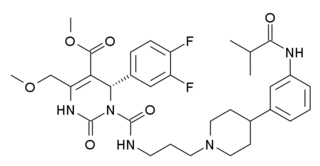
H2 antagonists, sometimes referred to as H2RAs and also called H2 blockers, are a class of medications that block the action of histamine at the histamine H2 receptors of the parietal cells in the stomach. This decreases the production of stomach acid. H2 antagonists can be used in the treatment of dyspepsia, peptic ulcers and gastroesophageal reflux disease. They have been surpassed by proton pump inhibitors (PPIs); the PPI omeprazole was found to be more effective at both healing and alleviating symptoms of ulcers and reflux oesophagitis than the H2 blockers ranitidine and cimetidine.

Histamine is an organic nitrogenous compound involved in local immune responses, as well as regulating physiological functions in the gut and acting as a neurotransmitter for the brain, spinal cord, and uterus. Since histamine was discovered in 1910, it has been considered a local hormone (autocoid) because it lacks the classic endocrine glands to secrete it; however, in recent years, histamine has been recognized as a central neurotransmitter. Histamine is involved in the inflammatory response and has a central role as a mediator of itching. As part of an immune response to foreign pathogens, histamine is produced by basophils and by mast cells found in nearby connective tissues. Histamine increases the permeability of the capillaries to white blood cells and some proteins, to allow them to engage pathogens in the infected tissues. It consists of an imidazole ring attached to an ethylamine chain; under physiological conditions, the amino group of the side-chain is protonated.

A receptor antagonist is a type of receptor ligand or drug that blocks or dampens a biological response by binding to and blocking a receptor rather than activating it like an agonist. Antagonist drugs interfere in the natural operation of receptor proteins. They are sometimes called blockers; examples include alpha blockers, beta blockers, and calcium channel blockers. In pharmacology, antagonists have affinity but no efficacy for their cognate receptors, and binding will disrupt the interaction and inhibit the function of an agonist or inverse agonist at receptors. Antagonists mediate their effects by binding to the active site or to the allosteric site on a receptor, or they may interact at unique binding sites not normally involved in the biological regulation of the receptor's activity. Antagonist activity may be reversible or irreversible depending on the longevity of the antagonist–receptor complex, which, in turn, depends on the nature of antagonist–receptor binding. The majority of drug antagonists achieve their potency by competing with endogenous ligands or substrates at structurally defined binding sites on receptors.

Amoxapine, sold under the brand name Asendin among others, is a tricyclic antidepressant (TCA). It is the N-demethylated metabolite of loxapine. Amoxapine first received marketing approval in the United States in 1992, approximately 30 to 40 years after most of the other TCAs were introduced in the United States.

Histamine H3 receptors are expressed in the central nervous system and to a lesser extent the peripheral nervous system, where they act as autoreceptors in presynaptic histaminergic neurons and control histamine turnover by feedback inhibition of histamine synthesis and release. The H3 receptor has also been shown to presynaptically inhibit the release of a number of other neurotransmitters (i.e. it acts as an inhibitory heteroreceptor) including, but probably not limited to dopamine, GABA, acetylcholine, noradrenaline, histamine and serotonin.

The H1 receptor is a histamine receptor belonging to the family of rhodopsin-like G-protein-coupled receptors. This receptor is activated by the biogenic amine histamine. It is expressed in smooth muscles, on vascular endothelial cells, in the heart, and in the central nervous system. The H1 receptor is linked to an intracellular G-protein (Gq) that activates phospholipase C and the inositol triphosphate (IP3) signalling pathway. Antihistamines, which act on this receptor, are used as anti-allergy drugs. The crystal structure of the receptor has been determined (shown on the right/below) and used to discover new histamine H1 receptor ligands in structure-based virtual screening studies.

Astemizole was a second-generation antihistamine drug that has a long duration of action. Astemizole was discovered by Janssen Pharmaceutica in 1977. It was withdrawn from the market globally in 1999 because of rare but potentially fatal side effects.

H2 receptors are positively coupled to adenylate cyclase via Gs alpha subunit. It is a potent stimulant of cAMP production, which leads to activation of protein kinase A. PKA functions to phosphorylate certain proteins, affecting their activity. The drug betazole is an example of a histamine H2 receptor agonist.

ABT-239 is an H3-receptor inverse agonist developed by Abbott. It has stimulant and nootropic effects, and has been investigated as a treatment for ADHD, Alzheimer's disease, and schizophrenia. ABT-239 is more active at the human H3 receptor than comparable agents such as thioperamide, ciproxifan, and cipralisant. It was ultimately dropped from human trials after showing the dangerous cardiac side effect of QT prolongation, but is still widely used in animal research into H3 antagonists / inverse agonists.

Cipralisant (GT-2331, tentative trade name Perceptin) is an extremely potent histamine H3 receptor ligand originally developed by Gliatech. Cipralisant was initially classified as a selective H3 antagonist, but newer research (2005) suggests also agonist properties, i. e. functional selectivity. Cipralisant seemed to be well tolerated during early testing, entering Phase II trials for ADHD in 2000.

Antihistamines are drugs which treat allergic rhinitis, common cold, influenza, and other allergies. Typically, people take antihistamines as an inexpensive, generic drug that can be bought without a prescription and provides relief from nasal congestion, sneezing, or hives caused by pollen, dust mites, or animal allergy with few side effects. Antihistamines are usually for short-term treatment. Chronic allergies increase the risk of health problems which antihistamines might not treat, including asthma, sinusitis, and lower respiratory tract infection. Consultation of a medical professional is recommended for those who intend to take antihistamines for longer-term use.
The neuromedin U receptors are two G-protein coupled receptors which bind the neuropeptide hormones neuromedin U and neuromedin S. There are two subtypes of the neuromedin U receptor, each encoded by a separate gene.
An H3 receptor antagonist is a classification of drugs used to block the action of histamine at the H3 receptor.

A-349,821 is a potent and selective histamine H3 receptor antagonist (or possibly an inverse agonist). It has nootropic effects in animal studies, although there do not appear to be any plans for clinical development at present and it is currently only used in laboratory research.

Conessine is a steroidal alkaloid found in a number of plant species from the family Apocynaceae, including Holarrhena floribunda, Holarrhena antidysenterica and Funtumia elastica. It acts as a histamine antagonist, selective for the H3 subtype (with an affinity of pKi = 8.27; Ki = ~5 nM). It was also found to have long CNS clearance times, high blood–brain barrier penetration and high affinity for the adrenergic receptors.
GSK-189,254 is a potent and selective H3 histamine receptor inverse agonist developed by GlaxoSmithKline. It has subnanomolar affinity for the H3 receptor (Ki = 0.2nM) and selectivity of over 10,000x for H3 over other histamine receptor subtypes. Animal studies have shown it to possess not only stimulant and nootropic effects, but also analgesic action suggesting a role for H3 receptors in pain processing in the spinal cord. GSK-189,254 and several other related drugs are currently being investigated as a treatment for Alzheimer's disease and other forms of dementia, as well as possible use in the treatment of conditions such as narcolepsy, or neuropathic pain which do not respond well to conventional analgesic drugs.

Proxyfan is a histamine H3 receptor ligand which is a "protean agonist", producing different effects ranging from full agonist, to antagonist, to inverse agonist in different tissues, depending on the level of constitutive activity of the histamine H3 receptor. This gives it a complex activity profile in vivo which has proven useful for scientific research.

JNJ-5207852 is a histamine antagonist selective for the H3 subtype. It has stimulant and nootropic effects in animal studies, and has been suggested as a possible treatment for some memory defects associated with epilepsy. JNJ-5207852 itself did not progress to clinical development due to poor pharmacokinetic characteristics, but the related compound JNJ-17216498 was in a Phase II clinical trial for the treatment of narcolepsy in 2007.

SNAP-7941 is a drug used in scientific research, which is a selective, non-peptide antagonist at the melanin concentrating hormone receptor MCH1. In initial animal studies it had promising anxiolytic, antidepressant and anorectic effects, but subsequent trial results were disappointing, and the main significance of SNAP-7941 is as the lead compound from which more potent and selective antagonists such as SNAP-94847 were developed, although it continues to be used for research into the function of the MCH1 receptor.

Bilastine is an antihistamine medication used to treat hives (urticaria) and inflammation of the eye (allergic conjunctivitis) caused by an allergy. It is a second-generation antihistamine and takes effect by selectively inhibiting the histamine H1 receptor, preventing these allergic reactions. Bilastine has an effectiveness similar to cetirizine, fexofenadine, and desloratadine. It was originally developed in Spain by FAES Farma.
















